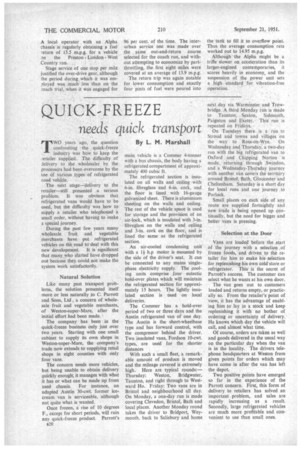QUICK-FREEZE
Page 54

If you've noticed an error in this article please click here to report it so we can fix it.
needs quick transport By I... M. Marshall TWO years ago, the question confronting the quick-freeze industry was how to keep the retailer supplied. The difficulty of delivery to the wholesaler by the processors had been overcome by the use of various types of refrigerated road vehicle.
The next stage—delivery to the retailer—still presented a serious problem. It was obvious that refrigerated vans would have to be used, but the difficulty was how to supply a retailer who telephoned a small order, without having to make a special journey.
During the past few years many wholesale fruit and vegetable merchants have put refrigerated vehicles on the road to deal with this new development. It is significant that many who started have dropped out because they could not make the system work satisfactorily. • Natural Solution Like many past transport problems, the solution presented itself more or less naturally to C. Parrott and Sons, Ltd, a concern of wholesale fruit and vegetable merchants, of Weston-super-Mare, after the initial effort had been made.
The company has been in the quick-freeze business only just over two years. Starting with one small cabinet to supply its own shops in Weston-super-Mare, the company's trade now extends to supplying retail shops in eight counties with only four vans.
The concern needs more vehicles, but being unable to obtain delivery quickly enough; it manages with what it has or what can be made up from used chassis. For instance, an adapted Austin 30-cwt. former icecream van is serviceable, although not quite what is wanted.
Once frozen, a rise of 10 degrees F., except for short periods, will ruin any quick-freeze product. Parrott's B20 main vehicle is a Commer 4-tonner with a bus chassis, the body having a refrigerated compartment of approximately 400 cubic ft.
The refrigerated section is insulated on all walls and ceiling with 6-in. fibreglass and 6-in, cork, and the floor is lined with 16-gauge galvanized sheet. There is aluminium sheeting on the walls and ceiling. The rest of the vehicle space is used for storage and the provision of an air-lock, which is insulated with 3-in. fibreglass on the walls and ceiling and 3-in, cork on the floor, and is lined the same as the refrigerated section.
An air-cooled condensing unit with a 1 h.p motor is mounted by the side of the driver's seat. It can be connected to any mains singlephase electricity supply. The cooling units comprise four eutectic hold-over plates which will maintain the refrigerated section for approximately 15 hours. The lightly insulated section is used on local deliveries.
The Commer has a hold-over period of two or three days and the Austin refrigerated van of one day. The Austin is the short-wheelbase type and has forward control, with the compressor behind the driver. Two insulated vans, Fordson 10-cwt. types, are used for the shorter distances With such a small fleet, a remarkable amount of produce is moved and the mileage covered is extremely high. Here are typical rounds:— Thursday: Weston, Bridgwater, Taunton, and right through to Westward Ho. Friday: Two vans are in Bristol and neighbourhood all day. On Monday, a one-day run is made covering Clevedon, Bristol, Bath and local places. Another Monday round takes the driver to Bridport, Weymouth, back to Salisbury and home next day via Warminster and Trowbridge. A third Monday run is made to Taunton, Seaton, Sidmouth, Paignton and Exeter. This run is repeated on Fridays.
On Tuesdays there is a run to Stroud and towns and villages on the way to Ross-on-Wye. On Wednesday and Thursday, a two-day run with the big refrigerated van to Oxford and Chipping Norton is made, returning through Swindon, and a Wednesday-Thursday journey with another van covers the territory around Bristol, Bath, Gloucester and Cheltenham. Saturday is a short day for local runs and one journey to Po rlock.
Small places on each side of any route are supplied fortnightly and new trade is being opened up continually, but the need for bigger and better vans is pressing.
Selection at the Door
Vans are loaded before the ,start of the journey with a selection of frozen foods, and driven to the retailer for him to make his selection for replenishing his own cold store or refrigerator. This is the secret of Parrott's success. The customer can select what he wants at his own door.
The van goes out to customers loaded and returns empty, or practically so. From the retailer's point of view, it has the advantage of enabling him to lay in a stock and keep replenishing it with no bother of ordering or uncertainty of delivery. He knows which day the vehicle will call, and almost what time.
Of course, orders are taken as well and goods delivered in the usual way on the particular day when the van is in the locality. The drivers telephone headquarters at Weston from given points for orders which may have come in after the van has left the depot.
Two positive points have emerged so far in the experience of the Parrott concern. First, this form of delivery to retailers has solved an important problem, and sales are rapidly increasing as a -result. Secondly, large refrigerated vehicles are much more profitable and convenient to use than small ones.




























































































